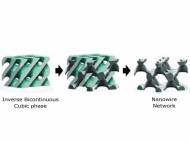Bioinspired nanomaterial could boost electrode efficiency
 Inspired by structures found in the nature’s own fuel cells and solar cells (mitochondria and chloroplasts), researchers at the University of Reading have patented a new method to create electrode coatings with a thousand-fold increase in surface area compared to a flat electrode. The increased contact surface could lead to more efficient and greener vehicles, rechargeable batteries and solar cells.
Inspired by structures found in the nature’s own fuel cells and solar cells (mitochondria and chloroplasts), researchers at the University of Reading have patented a new method to create electrode coatings with a thousand-fold increase in surface area compared to a flat electrode. The increased contact surface could lead to more efficient and greener vehicles, rechargeable batteries and solar cells.
The development of the technique was carried out by Dr Samina Akbar when she was a PhD student at the University of Reading, in a joint project between the research groups of Dr Adam Squires and Dr Joanne Elliott. The process works in water using a technique known as electrochemical deposition, and can be applied to any conducting electrode. Resulting nanostructure is a network of tiny wires, millionths of a millimeter in size, created by growing the metal in a template made from a plant molecule. This creates a bicontinuous cubic phase structure.
The unique 3D nanostructure enables improved conductivity and is the ideal shape for a high area electrode to create a more effective energy supply. This larger surface means that conversion of fuel or sunlight into electricity can take place in a smaller, more compact cell, making the cells cheaper to produce.
Patented manufacture process is easily applicable in creation of low cost electrodes, and it can be used for mass production. The chemical reaction to create the energy also takes place at room temperature, thus allowing the cells to be fitted to cheap materials such as plastic for the first time. On the other hand, the technique could be used to create energy storage devices with much greater capacity compared to traditional cells.
“The method of production is chemically mild, environmentally friendly and crucially takes place at room temperature, which means that electrodes could be fitted to a range of other materials. It will allow, for example, photovoltaic cells to be located on a plastic base rather than the currently used metal or glass, which will make renewable energy technologies more flexible, lightweight and cost effective”, said Dr Adam Squires, Lecturer at the University of Reading Department of Chemistry.
The novel method developed by the University of Reading researchers could be used to coat electrodes in next-generation fuel cells, hybrid or electric vehicles, photovoltaic cells, rechargeable batteries or battery production for a wide range of green technologies.
For more information, read the article published in the journal Advanced Materials: “Facile Production of Ordered 3D Platinum Nanowire Networks with “Single Diamond” Bicontinuous Cubic Morphology”.









Leave your response!